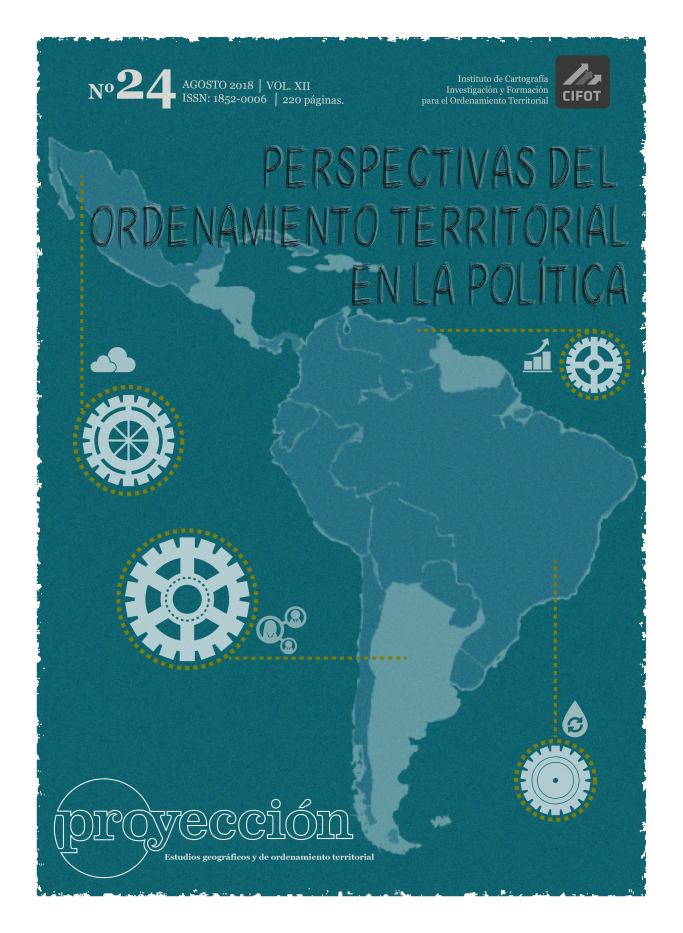Los Lineamientos Estratégicos Metropolitanos como política para la consolidación y completamiento del territorio de la ciudad en el caso de los vacíos urbanos del área Metropolitana de Tucumán
Palabras clave:
Ordenamiento territorial, Vacíos urbanos, Políticas públicasResumen
La reciente publicación de los Lineamientos Estratégicos Metropolitanos AM Tucumán (LEM AMT); resultado de un trabajo de consultoría que reunió a profesionales de diferentes especialidades en torno al Observatorio de Fenómenos Urbanos y Territoriales de la Facultad de Arquitectura y Urbanismo de la Universidad Nacional de Tucumán; incorpora nuevas posibilidades en el ámbito de político de la Ordenación del Territorio. Se busca poner en discusión la capacidad de los LEM AMT de producir cambios en el uso del suelo del territorio del Sistema Metropolitano de Tucumán (SIMeT), en especial a lo que respecta al Lineamiento 2 / Consolidación y Completamiento de la Estructura Metropolitana. Para ello se analizan definiciones sobre vacíos urbanos desde distintos abordajes, se identifica los solares vacíos y se confronta los datos obtenidos del espacio territorial con los programas y proyectos descriptos en el respectivo lineamiento.
Los resultados de estos análisis permiten identificar la relevancia de los grandes vacíos fiscales y las potencialidades de su aprovechamiento para plantear la necesidad de un cambio en las políticas públicas hacia el interior de las instituciones de incumbencia nacional en un modelo de ciudad más sustentable. La recuperación de las prácticas de Ordenación del Territorio conseguida a partir de estos LEM AMT, que por su carácter multi-espacial ponen su eje en lo Metropolitano como espacio de conflicto, abren nuevas posibilidades para las definición de políticas territoriales que incluyan a Instituciones como las Fuerzas Armadas, los Ferrocarriles y las Universidades en la discusión y articulación en pos de la sostenibilidad de un espacio tan complejo como en el SIMeT.
Citas
CLICHEVSKY, N. (2000). Informalidad y segregación urbana en América Latina. Una aproximación. Santiago de Chile,: CEPAL.
COMISIÓN ECONÓMICA PARA AMÉRICA Y EL CARIBE. (2017). Panoramamultimencional del desarrollo urbano en américa latina y el Caribe. Santiago de Chile: Naciones Unidas.
DAMI. (2017). Atlas Metropolitano. San Miguel de Tucumán: FAU, 27.
DAMI. (2017). Informe Final Lem Dami Tucuman. San Miguel de Tucumán,.
DAMI. (2017). "Portal DAMI". [En Línea]. Disponible en: http://www.dami.uec.gov.ar/ [Acceso el 01 de septiembre de 2017]
DE ARAUJO LARANGEIRA, A.( 2004). Tierra Vacante en las ciudades de América latina: Desafíos y Oportunidades. Rio de janeiro: Lincoln Institute of Land Policy.
DE SOLÀ MORALES, I. (2002). Territorios. Barcelona: Gustavo Gili.
FAUSTO, A. y RÁVAGO, J. ( 2001). ¿Vacíos urbanos o vacíos de poder metropolitano? Ciudades . Universidad de Guadalajara, Centro de Estudios Metropolitanos, Guadalajara, México, nº 49 (Ene-mar): 33-39.
LA GACETA.( 2017). El Estadio Único se realizaría en Banda del Río Salí y albergaría a 60.000 personas. La Gaceta de Tucumán, 18 de julio.
OFUT (2017). Observatorio FAU. [En Línea]. Disponible en: http://www.observatoriofau.org/gis/ [Acceso el 1 de Marzo de 2017 2017]
PEIMBERT, A. J. (2011). La representación del vacío. Atlas abreviado de los paisajes intersticiales en la ciudad de Mexicali, México. Proceedings of 7VCT (7TH VIRTUAL CITIES AND TERRITORIES). Lisboa pp.45-49.
ROBLEDO, L. (2011). Vacíos urbanos en la cuenca del reconquista: la reconversión del uso del suelo urbano en grandes predios militares como respuesta a la fragmentación sociourbana. Quilmes, Universidad Nacional de Quilmes. Mundo urbano, nº 37
Descargas
Publicado
Cómo citar
Número
Sección
Licencia

Esta obra está bajo una licencia internacional Creative Commons Reconocimiento-NoComercial-CompartirIgual 3.0.
La revista Proyección establece las siguientes condiciones de publicación para los/as autores/as:
- Los/as autores/as conservan los derechos de autor y ceden a la revista el derecho de publicación bajo la Licencia Creative Commons Atribución-No Comercial-CompartirIgual 3.0 No portada (CC BY-NC-SA 3.0) que permite a terceros copiar, distribuir, exhibir y ejecutar la obra citando siempre la fuente y los datos de autoría según la norma prevista por la Revista Proyección. Esta licencia no permite el uso de la obra con fines comerciales.
- Todos los trabajos publicados por Proyección, Estudios Geográficos y de Ordenamiento Territorial serán bajo la modalidad de gratuidad para autores/as y lectores/as.




























